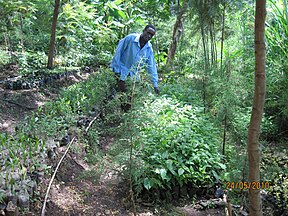Kerio Valley
| Kerio Valley | |
|---|---|

Tree nursery in the Kerio Valley.
|
|
| Floor elevation | 1,000 m (3,300 ft) |
| Long-axis length | 80 kilometres (50 mi) |
| Width | 10 kilometres (6.2 mi) |
| Geography | |
| Coordinates | 0°38′24″N 35°36′31″E / 0.6401°N 35.6086°ECoordinates: 0°38′24″N 35°36′31″E / 0.6401°N 35.6086°E |
| Population centers | Kimwarer |
Kerio Valley lies between the Tugen Hills and the Elgeyo Escarpment in Kenya. It sits at an elevation of 1,000 meters in the Great Rift Valley.
The isolated Kerio Valley is situated in a narrow, long strip that is approximately 80 km by 10 km wide at its broadest, through which the Kerio River flows. 4,000 feet (1,200 m) deep, the valley lies between the Cherangani Hills and the Tugen Hills.
The Elgeyo Escarpment rises more than 1,830 metres (6,000 ft) above it in places. It has semi-tropical vegetation on the slopes, while the floor of the valley is covered by dry thorn bush. The most comfortable time of the year is in July and August, when the rains have ended and the temperatures are not excessive.
The Kerio Valley National Reserve has been established since 1983 along the Kerio River to the north of Lake Kamnarok.
The Kerio Valley is the site of elaborate irrigation systems that were constructed during earlier periods of history. These structures are believed to have been built by descendants of the Neolithic Afro-Asiatic peoples who introduced domesticated plants and animals to the Great Lakes region—a succession of societies collectively known as the Stone Bowl cultural complex. Most of these early northern migrants are said to have been absorbed by later movements of Nilotic and Bantu peoples. Although the particular irrigation systems in the Kerio Valley are today maintained by the Marakwet subgroup of the Kalenjin Nilotes, the latter aver that they were the work of a northern people of peculiar language called the Sirikwa, who were later decimated by pestilence. According to the Marakwet, the Sirikwa "built the furrows, but they did not teach us how to build them; we only know how to keep them as they are."
...
Wikipedia

